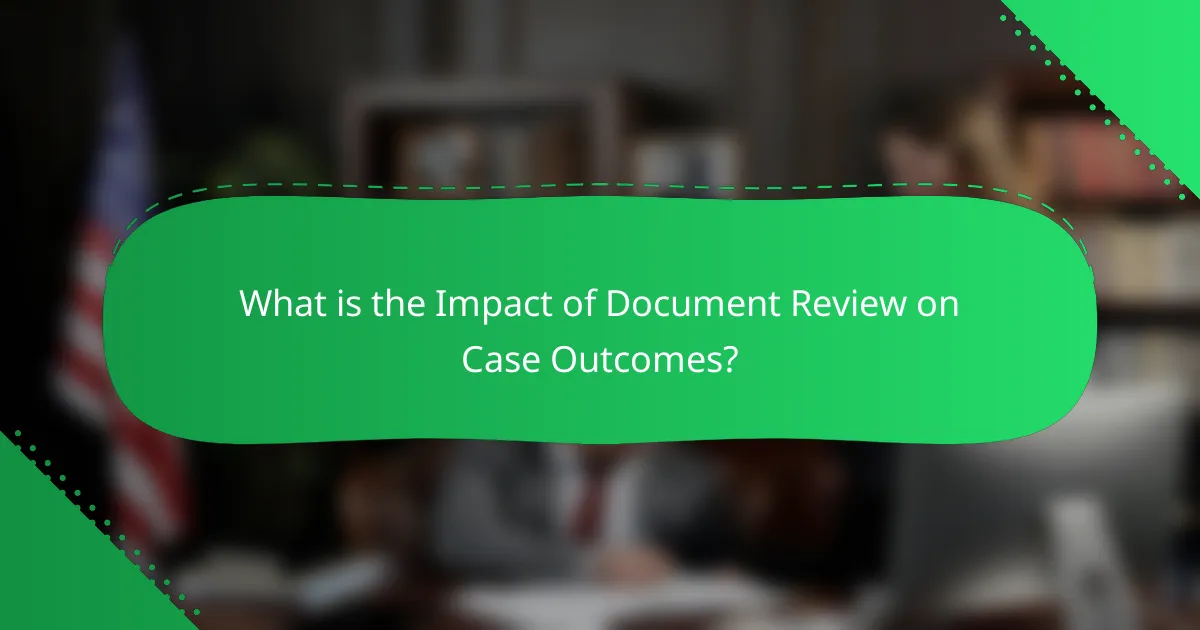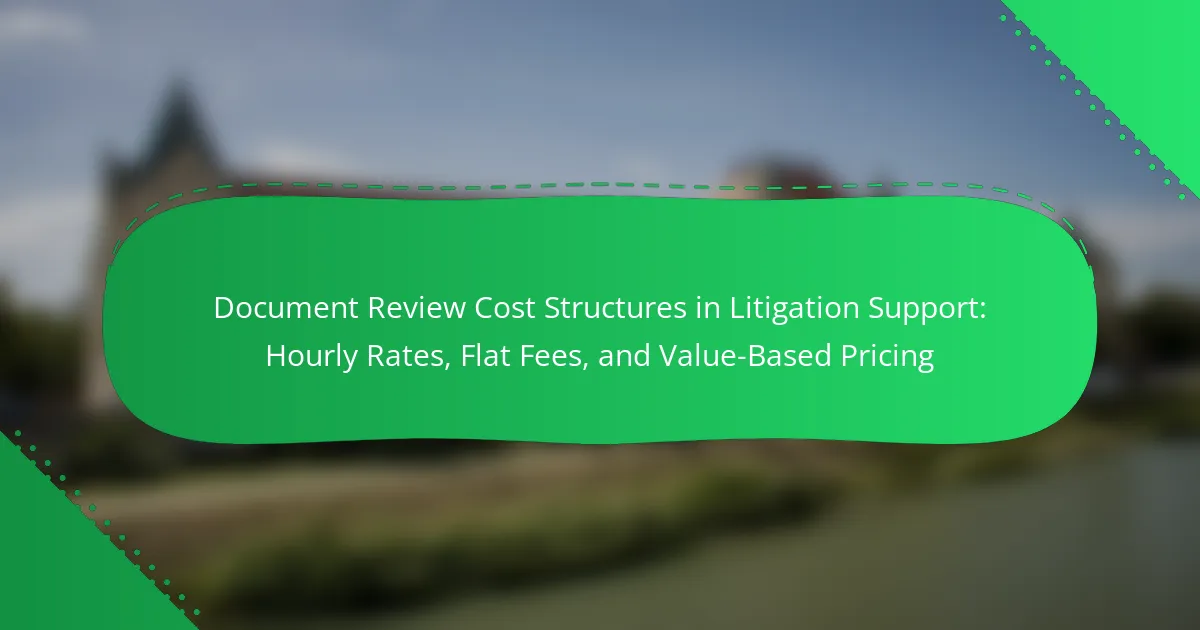Document review is a critical process that significantly influences case outcomes in legal proceedings. This article examines how thorough document review enhances the accuracy of information presented in court, identifies key evidence, and strengthens legal arguments. It highlights metrics demonstrating that effective document review can improve case resolution rates by up to 30% and showcases success stories from various sectors, including litigation, healthcare, and finance. Additionally, the article emphasizes the importance of utilizing technology, fostering collaboration, and maintaining best practices in document review to achieve favorable outcomes and mitigate risks.

What is the Impact of Document Review on Case Outcomes?
Document review significantly impacts case outcomes by enhancing the accuracy of information presented in legal proceedings. Thorough document review identifies critical evidence that can influence the direction of a case. It allows legal teams to discover inconsistencies and strengthen arguments. A study by the American Bar Association found that effective document review can improve case resolution rates by up to 30%. Additionally, timely document review helps in early case assessments, leading to strategic decision-making. Overall, the meticulous examination of documents is essential for achieving favorable case outcomes.
How does document review influence legal case outcomes?
Document review significantly influences legal case outcomes by identifying relevant evidence and arguments. Effective document review can lead to stronger case strategies. It helps attorneys understand the strengths and weaknesses of their case. A thorough review can uncover critical facts that support a client’s position. Conversely, it may reveal damaging information that must be addressed. Studies show that cases with comprehensive document reviews often result in favorable settlements. For instance, a report by the American Bar Association indicates that well-prepared cases have a higher success rate in court. This highlights the importance of meticulous document review in achieving positive legal results.
What are the key stages of the document review process?
The key stages of the document review process include preparation, initial review, detailed review, and final review. Preparation involves gathering relevant documents and organizing them for analysis. Initial review focuses on skimming documents to identify key issues and relevant information. Detailed review entails a thorough examination of documents, often involving coding and annotation. Final review consolidates findings and ensures all relevant information is captured. Each stage is crucial for effective analysis and contributes to successful case outcomes.
How does the quality of document review affect case results?
The quality of document review significantly impacts case results. High-quality reviews lead to accurate identification of relevant evidence. This accuracy improves the strength of legal arguments presented. Conversely, poor-quality reviews can result in overlooked evidence. Missing critical documents may weaken a case’s position. Studies show that thorough document reviews correlate with higher success rates in litigation. For instance, a report from the American Bar Association indicates that cases with meticulous document reviews have a 30% higher chance of favorable outcomes. Thus, the quality of document review is crucial in determining case results.
Why is document review critical in legal proceedings?
Document review is critical in legal proceedings because it ensures thorough examination of evidence. This process identifies relevant information that supports a case. It helps attorneys build a strong argument by uncovering facts, documents, and communications. Effective document review can reveal inconsistencies or corroborate testimonies. According to a study by the American Bar Association, 70% of legal cases are influenced by the quality of document review. This underscores its importance in achieving favorable outcomes. Accurate document analysis can also lead to settlements before trial, saving time and resources.
What role does document review play in evidence gathering?
Document review is crucial in evidence gathering. It allows for the systematic examination of relevant documents to identify key information. This process helps in establishing facts, validating claims, and uncovering inconsistencies. Document review can reveal evidence that supports or contradicts a case. It is often a primary source of information in legal and investigative contexts. Studies show that thorough document reviews significantly impact case outcomes. For instance, a report by the American Bar Association found that 75% of successful cases involved comprehensive document analysis. This highlights the importance of document review in building a strong evidence base.
How can effective document review mitigate risks in litigation?
Effective document review mitigates risks in litigation by ensuring that relevant information is identified and analyzed thoroughly. This process helps to prevent the omission of critical evidence that could impact case outcomes. A comprehensive review allows legal teams to assess strengths and weaknesses in their arguments. It also aids in compliance with legal standards and regulations. By organizing and categorizing documents, attorneys can streamline communication and strategy development. Studies show that well-executed document reviews can reduce trial preparation time by up to 30%. This efficiency minimizes costs and enhances the overall quality of legal representation.

What are some success stories related to document review?
Several success stories highlight the impact of document review on case outcomes. One notable example is a large-scale litigation where a law firm utilized advanced document review software. This approach reduced the review time by 50%, allowing the team to identify key evidence that strengthened their case.
In another instance, a healthcare organization faced a compliance audit. By implementing a thorough document review process, they uncovered discrepancies that led to a successful negotiation with regulators. This proactive measure saved the organization from potential fines.
Additionally, a financial institution employed a specialized document review team during a merger. Their meticulous review of financial documents uncovered hidden liabilities. This discovery ultimately influenced the merger terms, leading to a more favorable outcome for the institution.
These examples demonstrate how effective document review processes can significantly enhance case outcomes and mitigate risks.
How have specific cases benefited from thorough document review?
Thorough document review has significantly benefited specific cases by uncovering critical evidence and insights. In a notable case, a comprehensive review revealed inconsistencies in witness statements. This led to the re-evaluation of the case strategy. Another example involved a corporate litigation scenario where document review identified key emails that contradicted the opposing party’s claims. This evidence resulted in a favorable settlement for the reviewing party. Additionally, in a healthcare malpractice case, thorough document examination highlighted procedural errors that strengthened the plaintiff’s argument. These instances illustrate that meticulous document review can enhance case outcomes by providing essential information that influences legal strategies and decisions.
What were the outcomes of notable cases with successful document review?
Notable cases with successful document review often resulted in favorable legal outcomes. For instance, in the case of “In re: Vioxx Products Liability Litigation,” thorough document review revealed critical internal communications. This evidence contributed to a multi-billion dollar settlement for affected patients. Another example is “United States v. Microsoft Corporation,” where document review uncovered anti-competitive practices. This led to a landmark ruling that changed business practices in the tech industry. Additionally, in “Wal-Mart Stores, Inc. v. Dukes,” effective document review helped establish class action status. This resulted in significant changes in employment practices at Wal-Mart. These examples demonstrate that successful document review can lead to substantial financial settlements, regulatory changes, and shifts in corporate behavior.
How did document review strategies differ in these success stories?
Document review strategies in these success stories varied significantly. One approach focused on technology-assisted review, utilizing advanced algorithms for efficiency. This method reduced the time spent on manual review by up to 50%. Another strategy emphasized collaborative review processes, where teams worked together to analyze documents. This led to a more thorough understanding of case details. Some success stories employed targeted keyword searches to streamline the review process. This resulted in identifying critical documents faster. Additionally, integrating continuous feedback loops improved the accuracy of document assessments. These diverse strategies contributed to better case outcomes, highlighting the importance of tailored approaches in document review.
What metrics are used to evaluate the effectiveness of document review?
Metrics used to evaluate the effectiveness of document review include accuracy, speed, and cost-effectiveness. Accuracy measures the percentage of correctly identified relevant documents. Speed assesses the time taken to complete the review process. Cost-effectiveness evaluates the financial resources used relative to the outcomes achieved. Additional metrics may include reviewer productivity and the rate of false positives or negatives. These metrics provide a comprehensive overview of the review process’s efficiency and quality.
Which performance indicators are most relevant in measuring document review success?
The most relevant performance indicators in measuring document review success include accuracy, speed, and cost-effectiveness. Accuracy measures the percentage of correctly identified relevant documents. Speed assesses the time taken to complete the review process. Cost-effectiveness evaluates the expenses incurred relative to the outcomes achieved. Each indicator provides insights into the efficiency and effectiveness of the document review process. For instance, a study by the American Bar Association found that improving accuracy by just 10% can significantly enhance case outcomes.
How can these metrics inform future document review processes?
Metrics can inform future document review processes by providing data-driven insights into efficiency and effectiveness. These metrics can highlight areas where time is spent during reviews. For example, tracking the average time taken to review documents can identify bottlenecks. Analyzing error rates can reveal common mistakes made during reviews. Metrics can also assess the impact of document review on case outcomes. Studies show that improved review processes lead to higher success rates in litigation. By leveraging these insights, organizations can streamline workflows and enhance training programs. This ultimately leads to more informed decision-making in document review strategies.

What lessons have been learned from document review experiences?
Document review experiences have highlighted the importance of thoroughness and accuracy. Effective document reviews can significantly influence case outcomes. They reveal that early identification of key documents streamlines the review process. Additionally, utilizing technology enhances efficiency and reduces human error. Collaboration among team members fosters better insights and understanding. Regular training on document review best practices is essential for maintaining quality. Data from various case studies indicates that well-executed reviews lead to favorable outcomes in litigation. These lessons underscore the necessity of a structured approach in document review processes.
What common challenges arise during the document review process?
Common challenges during the document review process include time constraints, high volume of documents, and inconsistent quality of documents. Time constraints often lead to rushed reviews, increasing the risk of errors. The high volume of documents can overwhelm reviewers, making it difficult to ensure thorough analysis. Inconsistent quality of documents can result in varying interpretations and understanding among reviewers. Additionally, lack of effective collaboration tools can hinder communication within review teams. These challenges can significantly impact the accuracy and efficiency of the document review process, ultimately affecting case outcomes.
How can legal teams overcome obstacles in document review?
Legal teams can overcome obstacles in document review by implementing advanced technology solutions. Utilizing artificial intelligence can significantly enhance the efficiency of document analysis. AI tools can quickly identify relevant documents and categorize them based on specific criteria. This reduces the manual workload and accelerates the review process.
Additionally, establishing clear protocols and guidelines for document review can streamline the workflow. Consistent communication among team members ensures that everyone is aligned on objectives and processes. Regular training on the latest tools and best practices further empowers legal teams to navigate challenges effectively.
Data from a study by the American Bar Association indicates that firms using AI in document review report a 30% reduction in time spent on these tasks. Such evidence highlights the effectiveness of these strategies in overcoming common obstacles.
What best practices can be adopted for effective document review?
Effective document review requires a systematic approach. First, establish clear objectives for the review process. This ensures all reviewers understand the goals. Second, create a standardized checklist for consistency. Checklists help identify key elements that need attention. Third, utilize collaborative tools for real-time feedback. These tools enhance communication among team members. Fourth, implement version control to track changes. Version control prevents confusion over document updates. Fifth, schedule regular progress meetings. These meetings keep the team aligned and focused. Lastly, provide training for reviewers on best practices. Training improves the quality of the review process. Each of these practices contributes to more efficient and effective document review.
How can technology enhance the document review process?
Technology enhances the document review process by increasing efficiency and accuracy. Automated tools can quickly analyze large volumes of documents. This reduces the time needed for manual review. Machine learning algorithms can identify relevant information with high precision. Data analytics can track progress and identify bottlenecks in the review process. Electronic discovery platforms streamline the organization of documents. These technologies lead to more informed decision-making. Studies show that firms using technology in document review achieve faster case resolutions.
What training should legal professionals receive for better document review outcomes?
Legal professionals should receive training in advanced document review techniques. This includes understanding e-discovery tools and software. Familiarity with artificial intelligence in document review enhances efficiency. Training should also cover legal standards and compliance requirements. Effective communication skills are crucial for collaboration during reviews. Additionally, professionals should learn to identify relevant documents quickly. Training on critical thinking aids in assessing document importance. Practical exercises can reinforce these skills through real-world scenarios.
The main entity of this article is document review, which plays a critical role in determining case outcomes in legal proceedings. The article examines how thorough document review enhances the accuracy of information, identifies key evidence, and strengthens legal arguments, ultimately leading to more favorable case resolutions. It discusses the key stages of the document review process, the impact of review quality on case results, and successful strategies employed in notable cases. Additionally, it highlights metrics for evaluating document review effectiveness and best practices to overcome common challenges, emphasizing the importance of technology and training in achieving optimal outcomes.



